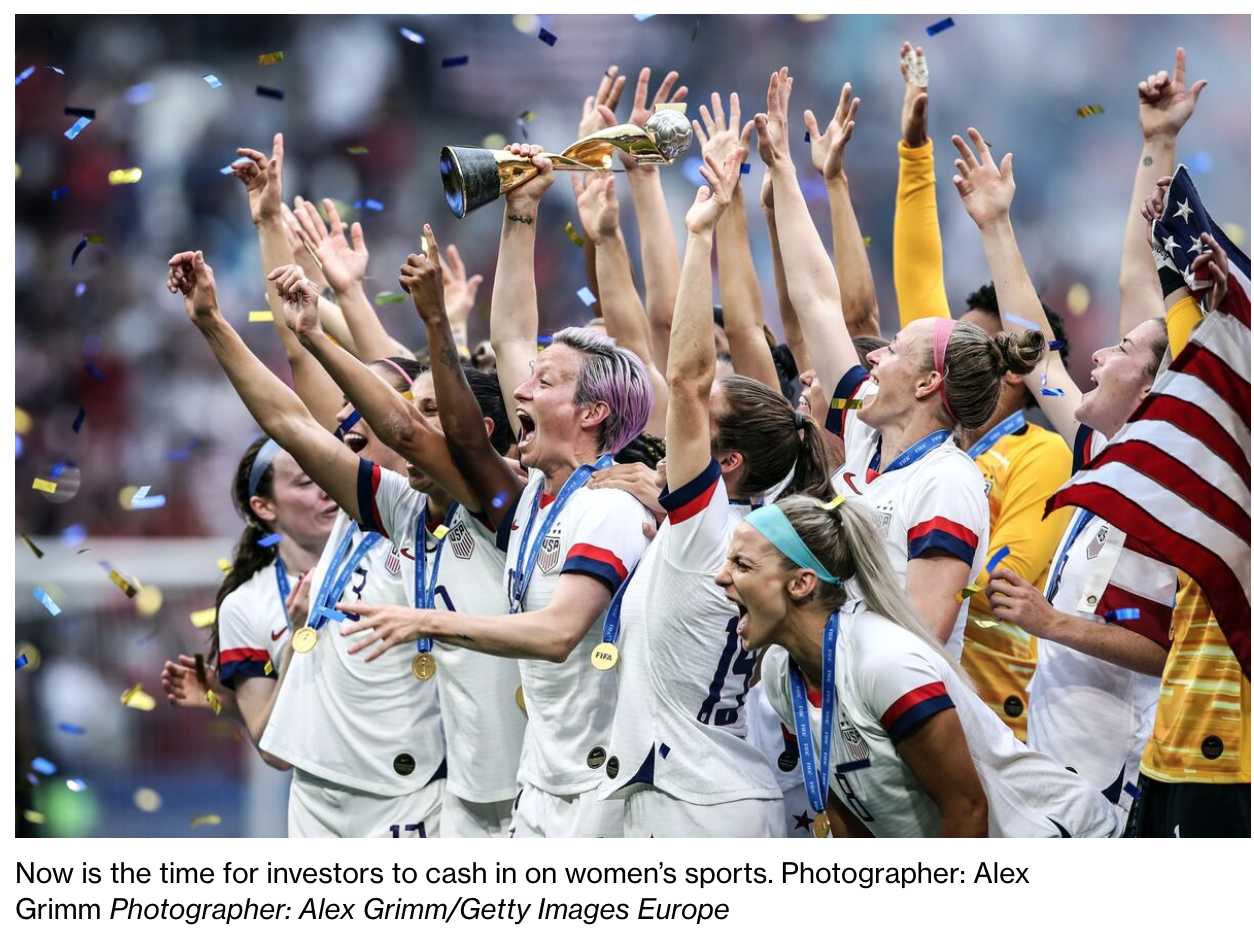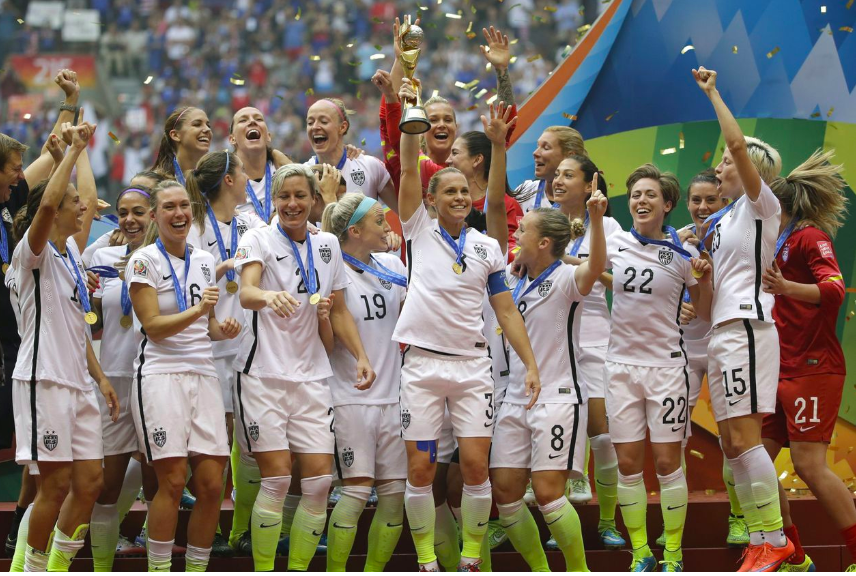US Women’s Soccer Games Out Earned Men’s Games
The 2015 World Cup title was a catalyst to boost women’s game revenues, which in recent years exceeded the men’s. US Women’s Soccer Games Outearned Men’s Games
In the three years after the U.S. women’s soccer team won the 2015 World Cup, U.S. women’s games generated more total revenue than U.S. men’s games, according to audited financial reports from the U.S. Soccer Federation.
The ability of the women’s team to generate gate revenues that equals or exceeds the men’s team is an important battleground in the U.S. women’s March 8 gender-discrimination lawsuit against the federation.
Related:
Women’s Soccer Team Celebrations Draw World-Wide Criticism And Support
Move Over, Tennis And Golf. Networks And Brands Are Cashing In On Pickleball
Major League Cricket Takes Off In US
U.S. Soccer has made revenue generation a key part of its defense. In U.S. Soccer’s May 6 legal response to the suit, the federation said the men’s and women’s teams are separate organizations with separate collective-bargaining agreements.
It said that any alleged pay differential between the men’s and women’s teams is “based on differences in the aggregate revenue generated by the different teams and/or any other factor other than sex.”
But U.S. Soccer’s numbers show that while men’s games used to generate millions more than women’s games, in recent years the gap in revenue all but disappeared.
From 2016-2018, women’s games generated about $50.8 million in revenue compared with $49.9 million for the men, according to U.S. soccer’s audited financial statements.
In 2016, the year after the World Cup, the women generated $1.9 million more than the men. Game revenues are made up mostly of ticket sales. In the last two years, at least, the men’s tally includes appearance fees that opposing teams pay the U.S. for games.
“The event revenue from the USWNT demonstrates the potential that can be realized when investment is made,” said Becca Roux, executive director of the U.S. women’s national team’s players association.
“While there is still a long way to go, I applaud U.S. Soccer, their partners, and our partners for the new marketing initiatives over the past couple of years. I hope it serves as a case study and example for other federations around the world to emulate.”
U.S. Soccer Declined To Comment
To be sure, ticket sales are only one revenue stream that the national teams help generate. U.S. Soccer brought in nearly $49 million in marketing and sponsorship revenue in 2018, nearly half of its $101 million operating revenue, according to federation records.
Marketing and sponsorship revenue includes the sale of broadcast rights for U.S. Soccer games and sponsorships sold to Budweiser, Nike and others.
But U.S. Soccer sells broadcast rights and sponsorships as a bundle, not separately for each national team. That makes it difficult to parse the value that broadcasters or brands see in the men’s team versus the women’s team.
U.S. Soccer doesn’t earn broadcast-rights fees from World Cups. In the U.S., those tournaments’ English-language broadcast deals are between Fox Sports and FIFA.
But U.S. Soccer and Major League Soccer have a separate eight-year deal through 2022 with ESPN, Fox Sports and Univision Deportes for the right to broadcast other U.S. men’s and women’s soccer games along with MLS games.
TV ratings for U.S. men’s games tend to be higher than those for U.S. women’s games, according to data collected by U.S. Soccer.
David Neal, executive producer of FIFA World Cup on Fox and VP, production, said it was difficult to parse the broadcast value of U.S. men’s versus women’s games.
“I don’t know how you quantify that,” Neal said. “But right now the shining star of U.S. Soccer is the U.S. women’s national team. These women are heroes and I think that carries great value.”
The U.S. women have won an unmatched four Olympic gold medals and three World Cup titles, and are in France trying to win a fourth. The U.S. men have never won a World Cup and failed to qualify for the 2018 tournament.
The full U.S. men’s team doesn’t play in the Olympics, whose men’s competitions include mostly players under 23 years old.
There are signs that the U.S. women’s equal-pay fight has spurred more marketing deals with the federation.
Visa recently entered into a five-year deal with U.S. Soccer, and the company said it’s earmarked at least 50% of its investment for the U.S. women’s team and women’s soccer programming initiatives.
As part of its sponsorship as the official women’s deodorant of U.S. Soccer, Secret released an ad featuring soccer-playing girls.
It ends with an image of U.S. forward Alex Morgan and the words, “Secret supports equal pay for all.”
U.S. Soccer is a nonprofit organization whose charge is to govern soccer in the U.S. Its mission, stated on its tax filings, is to promote soccer and make it “the pre-eminent sport recognized for excellence in participation, spectator appeal, international competitions and gender equality.”
Share Your Thoughts
Should U.S. men’s and women’s player pay be tied to revenue, based on team results or determined some other way? Join the discussion below.
Updated: 7-19-2023
Women Athletes Are The Sports World’s Growth Stocks

This year’s World Cup kicks off as the upside potential of female competitors now exceeds that of their male counterparts.
Early projections show that this year’s Women’s World Cup could reach 2 billion viewers, nearly double the 1.12 billion fans who watched the 2019 edition of the tournament. Participating athletes have seen a surge of interest ahead of Thursday’s kickoff.
On Instagram, Swiss star Alisha Lehmann has watched her follower count hit 13.4 million, up 75% over the last year. That following is worth real money. According to ratings agency Nielsen Sports, a single Instagram post by Lehmann is worth $307,000 in media value to a sponsor.
Lehmann isn’t an outlier. Women’s sports are growing in popularity and value. Better yet, that growth is no longer dependent upon quadrennial events like the Olympics or World Cups (though, as this year’s tournament will likely prove, they certainly help).
Investors, who’ve long been on the sidelines of women’s sports, shouldn’t wait to cash in.
Though women athletes haven’t yet reached the moneyed heights of men — top male World Cup stars have far larger Instagram followings and media value — the growth potential is greater for them than it is for their male counterparts.
For example, in the US, the value of women’s professional soccer franchises have increased more than 10-fold in recent years.
In Los Angeles, the Angel City FC team ownership group paid a $2 million fee to join the National Women’s Soccer League in 2020; in April, a group led by private equity firm Sixth Street committed to a record $53 million expansion fee to place a NWSL team in San Francisco.
This should be a welcome sign to more investors, but they will have to confront some issues. Among other difficulties, men’s team sports are well established as media properties and enjoy prime television viewing slots — such as Saturday and Sunday afternoons in the autumn for college and professional football — that women’s sports can’t hope to challenge (for now).
Even leagues with followings and TV deals — such as the Women’s National Basketball Association — have had inconsistent schedules that make it difficult to become appointment viewing à la Monday Night Football. (That’s finally changing with a regular Friday night game for the WNBA this season.)
The barrier extends beyond live broadcasts of games. In 2019, only 5.4% of televised sports news and highlights were devoted to women’s sports. For years, these informal blackouts froze women’s sports into niche events.
Yet over the last half-decade, a confluence of factors has begun to shift this gendered field. First, a younger generation of sports fans is embracing the social activism that comes along with women’s sports.
“Women’s sport inherently stands for something, such as #MeToo, gender equality,” explains Kirsten Sibbit-Johnston, an associate director at the London-based Sports Consultancy, where she works with sports rights holders and investors. “The current success of women’s soccer in the US stems from the players being such great advocates and fighting for something, making a stand.”
Second, thanks to the growth of streaming, online highlights and social media, women’s sports have become more accessible than ever, driving growth in fandom — and activism.
A social media user who followed Megan Rapinoe for her LGBTQ advocacy might decide to pay attention to her goal-scoring capabilities this month, too (before she retires at the end of the year).
That’s good for the business of women’s sports. In 2021, one survey found that 50% of women’s sports fans ”strongly agree” that sponsors should seek ”to make the world a better place.” Just 20% of fans of men’s sports expressed the same sentiment.
That commitment, especially to gender equity, drives media rights and other deals. For example, in 2022, sponsorships for women’s sports grew 20% year-over-year worldwide.
This year, in perhaps the most notable deal, Ally Financial Inc. made a multimillion-dollar ad buy across ESPN properties that will send 90% of the money to women’s sports.
It’s not charity. Justin Nicolette, director of public relations for Ally’s sports and entertainment division, recently explained the buy to Fast Company: “People are so driven to support the brands that are supporting women’s sports.”
The numbers don’t lie. Viewership for the 2022 WNBA playoffs was up 22% over 2021; this year, the National Collegiate Athletics Association Women’s Final Four semifinals averaged 4.5 million television viewers, a 32% increase over 2022.
Last summer, an exhibition between the US and English women’s teams sold out in a day, drawing 78,000 fans to Wembley Stadium.
Inevitably, greater fan numbers and engagement are driving up the value of women’s sports leagues and franchises. In February, the WNBA’s Seattle Storm sold a 14% stake in the team at a $151 million valuation — more than 10 times the prior record for a WNBA team.
It’s not just US sports, either: In India, five new women’s cricket team franchises were recently sold at auction for a combined $572.4 million.
For now, major men’s sports are worth more. National Football League, National Basketball Association and English Premier League franchises currently sell for billions. But despite impressive growth over the decades, NBA franchises aren’t going to grow 10-fold over the next five years, or 50.
Women’s sports are already doing it. This year’s Women’s World Cup is a reminder of just how culturally relevant and lucrative they have become. For investors keen to get a piece of the global sports market, the best opportunity is now in front of them.
Related Article:
When Is It Safe For Children To Start Strength Training? (#GotBitcoin?)
33 Resistance Band Exercises You Can Do Literally Anywhere (#GotBitcoin?)
She’s Powerlifting At 76, So You’re Officially Out Of Excuses (#GotBitcoin?)
Secrets of ‘UltraGeezer,’ Earth’s Fastest 70-Year-Old Distance Runner (#GotBitcoin?)
The Benefits of Grounding or Earthing For Improved Health (Dramatically Reduces Inflammation)
Ayurvedic (Holistic) Medicine Has 5000 Years Of Experience Over Western Medicine (#GotBitcoin?)
Understanding The Gut Microbiome
Food, The Gut’s Microbiome And The FDA’s Regulatory Framework
Germ-Killing Brands Now Want To Sell You Germs (#GotBitcoin?)
Pocket-Sized Spectrometers Reveal What’s In Our Foods, Medicines, Beverages, etc..
The Complete Guide To The Science Of Circadian Rhythms (#GotBitcoin?)
Billionaire is Turning Heads With Novel Approach To Fighting Cancer (#GotBitcoin?)
Fighting Cancer By Releasing The Brakes On The Immune System (#GotBitcoin?)
Over-Diagnosis And Over-Treatment Of Cancer In America Reaches Crisis Levels (#GotBitcoin?)
Cancer Super-Survivors Use Their Own Bodies To Fight The Disease (#GotBitcoin?)
Microbiome Live News
@metagenomics


Leave a Reply
You must be logged in to post a comment.